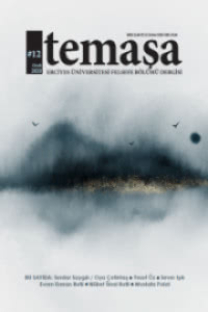Cezanne’dan Hareketle Merleau-Ponty’nin Fenomenolojisinde Sanatın Önemi
Maurice Merleau-Ponty’ye göre Paul Cezanne’ın sanatı nesnel dünyanın çeşitli temsillerini sunmaz, nesneyi açığa çıkışı içinde yakalar. O, Cezanne’ın resimlerinin saf doğayı, kökensel dünyayı resmettiğini düşünür. Ona göre fenomenolojinin amacı da kökensel dünyayı betimlemek ve yaşanan deneyimi felsefi düzeyde ele geçirmektir. O fenomenoloji ve sanatın, amaçlarına ulaşacaklarsa indirgeme yöntemini kullanmaları gerektiğini düşünür. Ona göre nesnel, verili ve türetilmiş olan indirgemeye tabi tutulmalı, varlık tezahürü içinde ortaya konmalıdır. Ancak onun fenomenoloji ve sanat arasında, indirgeme kavramı üzerinden kurduğu yakınlık, aynı zamanda fenomenoloji ve sanat arasında bir gerilimin oluşması tehlikesini de beraberinde getirir. Çünkü sanat, özellikle de Cezanne’ın resmi nesnel dünyayı indirgemeyi tamamlayabilir. Fenomenoloji soyut, kavramsal ve felsefi dili kullanmak zorundadır bu da fenomenolojik indirgemenin sınırlı kalmasına, dahası yaşanan deneyimi belli ölçüde çarpıtmasına yol açar. Bu makalede Merleau-Ponty’nin erken dönem düşünsel çerçevesi içinde kalınarak, fenomenolojiden beklentisi ve Cezanne’ın sanatında gördüğü felsefi önem ele alınacak, böylelikle söz konusu gerilim keşfedilmeye çalışılacak ve bu gerilimin Merleau-Ponty’nin erken dönem fenomenolojisi için olası sonuçları eleştirel bir değerlendirmeye tabi tutulacaktır.
Anahtar Kelimeler:
Cezanne, Fenomenoloji, İndirgeme, Merleau-Ponty, Resim, Sanat
The Importance of Art in Merleau-Ponty’s Phenomenology With Reference to Cezanne
For Maurice Merleau-Ponty, Paul Cezanne’s paintings seize phenomenon in its manifestation instead of giving various representations of the objective world. He thinks that Cezanne’s paintings portray pure nature, the primordial world. He also argues that the purpose of phenomenology is to describe the primordial world and capture the lived experience at philosophical level. To his view, phenomenology and art must use method of reduction if they are to fulfill their purpose. He suggests that the objective, given and derivative must be subjected to reduction and being must be captured in its manifestation. However, the intimacy which he established between phenomenology and art regarding the concept of reduction also brings the danger of a possible tension between them. Because, art, particularly Cezanne’s painting can complete the reduction of the objective world. Phenomenology must use the abstract, conceptual, and philosophical language. This causes the phenomenological reduction to stay limited, moreover to corrupt the lived experience. In this article, Merleau-Ponty’s expectation from phenomenology and the philosophical value which he sees in Cezanne’s art will be discussed by staying in early period of his thought. Thus, tension in question will be discovered and the potential consequences of it for Merleau-Ponty’s early period phenomenology will be critically evaluated.
Keywords:
Cezanne, Phenomenology, Reduction, Merleau-Ponty, Painting, Art,
___
- Chaplin, D. Adrienne. “Phenomenology: Merleau- Ponty and Sartre” in The Routledge Companion to Aesthetics, Editörler: B. Gaut and M. D. Lopes, 126-136. New York: Routledge, 2013.
- Encyclopedia Britannica. “Paul Cézanne,” Erişim 27 Mart 2023. https://www.britannica.com/biography/Paul-Cezanne
- Gilmore, Jonathan. “Between Philosophy and Art” in The Cambridge Companion to Merleau-Ponty, Editörler: T. Carman and M. Hansen, 291-317. Cambridge: Cambridge University Press, 2005.
- Hodge, Susie. CEZANNE 500 Görsel Eşliğinde Yaşamı ve Eserleri. Çeviren: S. Yörükler, İstanbul: Türkiye İş Bankası Kültür Yayınları, 2013.
- Johnson, A. Galen, “Ontology and Painting: “Eye and Mind” in The Merleau-Ponty Aesthetics Reader: Philosophy And Painting, Editörler. A. G. Johnson and B. M. Smith, 35-55. Evanston, Illinois: Northwestern University Press, 1993a.
- Johnson, A. Galen. “Phenomenology and Painting: “Cezanne’s Doubt” in The Merleau-Ponty Aesthetics Reader: Philosophy And Painting, Editörler: A. G. Johnson and B. M. Smith, 3-14. Evanston, Illinois: Northwestern University Press, 1993b.
- Merleau-Ponty, Maurice. “Cezanne’s Doubt” in The Merleau-Ponty Aesthetics Reader: Philosophy and Painting, Editörler: A. G. Johnson and B. M. Smith, 4-75. Evanston, Illinois: Northwestern University Press, 1993a.
- Merleau-Ponty, Maurice. “Eye and Mind” in The Merleau-Ponty Aesthetics Reader: Philosophy and Painting, Editörler: A. G. Johnson and B. M. Smith, 121-149. Evanston, Illinois: Northwestern University Press, 1993b.
- Merleau-Ponty, Maurice. Algılanan Dünya. Çeviren: Ö. Aygün, İstanbul: Metis Yayınları, 2017. Merleau-Ponty, Maurice. Algının Fenomenolojisi. Çeviren: E. Sarıkartal ve E. Hacımuratoğlu, İstanbul: İthaki Yayınları, 2016a.
- Merleau-Ponty, Maurice. Göz ile Tin. Çeviren: A. Soysal, İstanbul: Metis Yayınlar, 2016b.
- Merleau-Ponty, Maurice. Phenomenology of Perception. Çeviren: S. Colin, New York: Routledge, 2002.
- Merleau-Ponty, Maurice. Sense and Non-Sense. Çeviren: L. H. Dreyfus and A. P. Dreyfus, Evanston, Illinois: Northwestern University Press, 1964a.
- Merleau-Ponty, Maurice. Signs. Çeviren: C. R. McCleary, Evanston, Illinois: Northwestern University Press, 1964b. Merleau-Ponty, Maurice. The Visible and the Invisible. Çeviren: A. Lingis, Evanston, Illinois: Northwestern University Press, 1968.
- Merleau-Ponty, Maurice. The World of Perception. Çeviren: O. Davis, New York: Routledge, 2004.
- Silverman, J. Hugh. “Art and Aesthetics” in Merleau-Ponty Key Concepts, Editörler: R. Diprose and J. Reynolds, 95-108. New York: Routledge, 2014.
- Şan, Emre. “Estetik Dünyanın Logos’u” Dünyanın Teni içinde, Editör: K. Direk, 213-230. İstanbul: Metis Yayınları, 2017.
- Toadvine, Ted. “Phenomenology and “Hyper-Reflection” in Merleau-Ponty Key Concepts, Editörler: R. Diprose and J. Reynolds, 17-29. New York: Routledge, 2014.
- Williams, Forrest. “Cezanne, Phenomenology, and Merleau-Ponty” in The Merleau-Ponty Aesthetics Reader: Philosophy And Painting, Editörler: A. G. Johnson and B. M. Smith, 165-173. Evanston, Illinois: Northwestern University Press, 1993.
- Yüzgüller, Serap. Paul Cezanne. İstanbul: Hayalperest Yayınevi, 2017.
- ISSN: 2148-371X
- Yayın Aralığı: Yılda 2 Sayı
- Başlangıç: 2014
- Yayıncı: Prof. Dr. Arslan Topakkaya / Erciyes Üniversitesi Felsefe Bölümü
Sayıdaki Diğer Makaleler
Saul Aaron Kripke Semantiğinde Özel Adlar ve Gönderim Problemi
Gülsima URTEKİN, Serdar SAYGILI
Melike AKPINAR, Arslan TOPAKKAYA
Demokritos'un Euthumiê Anlayışı
İşlevselcilik Qualia'yı Reddeder mi?
Ferengi “Kazanç Kuralları” ve Niccolò Machiavelli
Tamer AKÇA, Cengiz Mesut TOSUN
Gazzali Descartes'ın Felsefesine Etki Etmiş Midir?
Patikalardan Otobanlara Hız Kültürü Karşısında Yavaşlamanın İmkanı Üzerine Bir Soruşturma
Kore Budizm Geleneğinin Kurucusu Jinul’un Hayatı ve Felsefi Kişiliği
Hatice KÖROĞLU TÜRKÖZÜ, Sümeyra SARAÇOĞLU
Ampirist Geleneğin Dil Felsefesine Katkıları
Cezanne’dan Hareketle Merleau-Ponty’nin Fenomenolojisinde Sanatın Önemi
